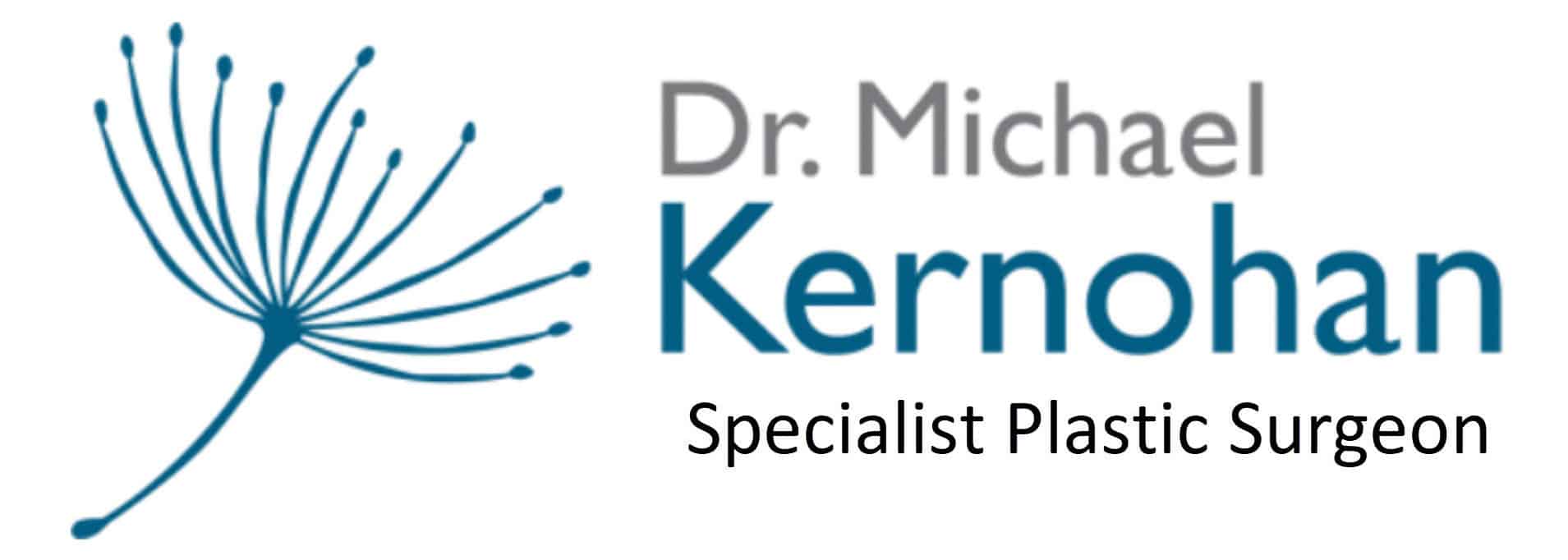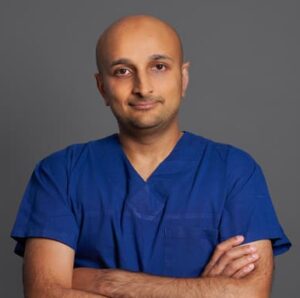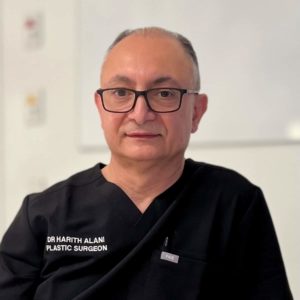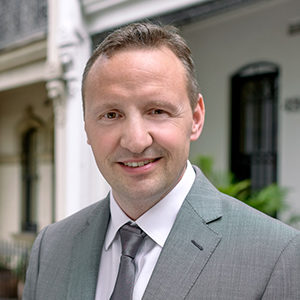Scar Revision Sydney – Scar Minimisation & Scar Excision by Plastic Surgeons
Any surgical, burn, or cut wound will lead to scar formation. Some scars are thin and disappear over time. Others might be large, overgrown (keloid) or might fail to properly heal. Such protruding and excessive scars can become a concern. Scar Revision Surgery performed by a plastic surgeon can usually help.
Large scars, keloid scars, and hypertrophic scars can be treated through scar reduction surgery. Both surgical and non-surgical procedures can help improve the appearance of scars to make them less noticeable.
Sydney Specialist Plastic Surgeons Dr Varun Harish, Dr Hari Alani and Dr Michael Kernohan are extensively trained in skin and scar surgery for scar minimisation. They can use Z-plasty, W-plasty, fat grafting, and other techniques to remove or reduce your scars. They can help smooth and reconstruct your skin to give it a natural contour and the optimal appearance.
They perform a range of Skin Surgery in locations across Sydney, Southwest Sydney and Southern Highlands. The Pure Visage Plastic Surgery Clinic is located in Gregory Hills.
Why do Scars Form?
Scars are a result of the skin’s natural healing process after trauma. Things like surgery, self harm cuts, accidental cuts, abrasions, and burns all usually result in tissue scarring.
Regardless of the mechanism of trauma, when the outer layer of skin (epidermis) is destroyed, specialised wound healing mechanisms are activated. Healing regenerative cells are recruited to restore the skin’s integrity.
Fibroblasts, a specialised type of cells, produce collagen, stimulate cell regeneration, blood vessel formation, and cell multiplication to close the wound. If the wound is not too deep and the edges are close, it’s usually closed with healthy skin cells (squamous cells). This way, no visible scar is formed.
If the wound edges are too far away or the wound is too deep, then fibroblasts will close the wound with collagen fibers, forming a scar. In the final stage of scar formation, the collagen contracts, giving scars their deformed tight appearance.
Why have Scar Revision Surgery?
A small, barely noticeable scar might not be a problem for most. In most cases, scars heal normally and only leave a thin visible line with a different skin tone. It might take a few months, but many small scars eventually become less visible.
However, scars can become a problem when they fail to heal and develop properly.
Different Types of Scars – What sort of scar do you have?
Wound healing problems can result in these different types of Scars:
1. Keloid Scar
This is one of the common wound-healing problems. Keloids are raised overgrown scars. The scar tissue forming does not just cover the wound. It grows excessively, bulges outward and sideways, extending beyond the wound edges and above the skin. We’re still not sure why exactly keloid scars form, but when they do, they may be disfiguring. The treatment of keloid scars involves keloid excision surgery, scar cryotherapy (with liquid nitrogen), steroid injections (into the keloid), and special silicone gel sheets. The choice of scar removal procedure depends on the size and location of the keloid scarring. There are several cosmetic surgery treatment options for keloids. **** Please Note that we do NOT OFFER CRYOTHERAPY at this clinic.
2. Hypertrophic Scar
These are another form of overgrown scars. Hypertrophic scarring means that excess scar tissue is formed within the wound. The difference between a keloid and a hypertrophic scar is that the latter does not extend beyond the wound edges. Treatment options for hypertrophic scars include silicone gel sheeting scar removal surgery, laser surgery, light therapy, and other cosmetic procedures. The type of surgery or treatment for excessive scarring is determined by the location and size of your scar.
3. Contracted Scar or Burn Scar
This type of scar usually forms from burn injuries (burn scars). Burns extensively destroy the outer cellular layers of skin, leading to excessive collagen formation and connective tissue contraction. The problem with contraction scars is that they can be very disfiguring (e.g. a facial scar) and can even interfere with joint mobility (e.g. knee, fingers, or elbow scars). Reconstructive surgery and advanced techniques are usually necessary to achieve a good functional and aesthetic outcome.
4. Acne Scarring
Acne usually leaves unsightly scars with an unpleasant cosmetic appearance. Different skin types respond differently to different treatment options for acne scars. Options include laser resurfacing, dermal fillers, and topical creams.
5. Other Scars – Skin Graft Scars, Self Harm Scars, Flat or Atrophic Scars
These scars can also be treated and improved. Contact Dr Kernohan’s team for advice.
When Should You Have Scar Revision?
Not every scar needs to be removed.
You should consider scar removal surgery if:
- You have wound healing problems (keloid, hypertrophic scar, or contractures)
- You have facial scarring (acne scars, wounds)
- You have scars in intimate places (lower abdomen scar, breast scars)
- Your scars are physically limiting mobility (joint scars)
In such cases, scar reduction procedures might be the next logical step for you. There are numerous cosmetic techniques to get rid of scars. Dr Kernohan will help you choose between surgical scar excision and non-surgical treatment options depending on your specific case.
Scar Revision Surgery Techniques
Scar removal surgery can be very complicated and requires great skill. There are several surgical techniques to remove a scar:
Elliptical incision and removal
For uncomplicated, yet cosmetically unappealing scars, simple scar excision alone is usually enough. This technique is the best scar revision technique for small and somewhat straight scars – just to reduce the size and make them more homogeneous. Dr Kernohan uses a blade to make an elliptical (fusiform) incision around the scar and takes the scar tissue off. He then uses a fine suture line to approximate the wound edges together. This allows the wound to properly heal while leaving a minimal scar line. Elliptical scar removal surgery can be used to remove keloid and hypertrophic scars, as well as unsightly scars.
Z-plasty
This is probably the best and most widely used scar revision surgical technique. A “Z” shaped incision is made along the scar, with the old scar line being the middle part of the Z (/), and the two limbs of the Z extending into normal healthy skin. Dr Kernohan takes out the old scar and then moves the new flaps in opposite directions before closing the wound with fine sutures. The benefits of Z-plasty are that it improves blood supply to allow healing, reforms the scar shape, and realigns the scar along the natural skin lines so that the new scar is much less noticeable. Z-plasty is one of the top methods to get rid of a scar.
Multiple Z-plasty
If you have a long scar or an irregular scar that’s not straight (curved), then Dr Kernohan will make multiple Z-plasty incisions along with the different parts of your scar. These carry the same concept as the original Z-plasty and allow for good cosmetic results in removing large scars.
Z-plasty variations
These are other forms of Z-plasty that might be performed depending on the shape of your scar. Some examples are half Z-plasty, four flap Z-plasty, S-plasty, and others.
W-plasty
This is another surgical method for removing scars. Dr Kernohan performs a W-shaped incision along the old scar. This scar revision surgery produces a much less visible scar by breaking the original scar line and making the new scar less noticeable. W-plasty is used to treat larger irregular scars and scars located in delicate areas (like forehead scars and cheek scars).
Geometric broken line closure (GBLC)
This is another scar revision procedure that shows excellent results in removing unsightly scars. GBLC has the same concept of Z-plasty and W-plasty – it de-regularises the scar line, making it less likely to reflect light, and less noticeable to an observer’s eyes. Geometric broken line closure creates a shark-teeth-like incision (with the teeth on either side of the incision). This is a good method to hide visible large scars and scars that are excessively misaligned with the natural skin curves and lines.
Y-V or V-Y Advancement
These scar reshaping methods are used to cosmetically improve contracted (V-Y) or loose scars (Y-V). In V-Y, Dr Kernohan releases the contracted scar tissue and closes the now wound to reduce tension. In Y-V advancement, a lax scar is tightened to restore the normal skin contour.
Skin grafting
In very large scars with an unsightly appearance, wound closure might not be possible after scar excision without a skin graft. Skin grafts can be taken from a hidden area of your body (e.g. thigh) to close the scar removal wound.
Non-Surgical Scar Treatments at our practice
There are several alternatives to scar surgery that might be an option for patients with superficial and small scars:
Fat grafting (autologous fat transfer)
This non-surgical scar removal technique entails the removal of depressed scars with fat injections. Fat is first taken from another site of your body with liposuction. Then it’s purified and turned into injections. Dr Kernohan will strategically inject fat to fill scar holes, bringing them in alignment with normal skin. Fat grafting is a good natural method to get rid of acne scars without surgery.
Dermal fillers
Filler agents are an excellent choice to treat acne scars and small depressed scars. These agents raise the bottom of a scar to the level of the normal surrounding skin, making scars less visible. The disadvantage of dermal fillers is that you’ll need a retouch every now and then.
Injectable medications
Steroids or Corticosteroids injections and other drugs might be used to treat bulky hypertrophic and keloid scars and cause them to regress. These agents work on the cellular level to reverse wound healing abnormalities.
Chemical peels
This scar removal technique involves the use of specialised creams and ointments that destroy and peel off the most superficial skin layers. This reduces the appearance and pigmentation of small superficial scars.
Dermabrasion
For small scars. This technique uses a specialised medical device to scrape off the outermost layers of the skin, allowing for new skin cells to move in and cover the area.
Scar Creams and ointments
There are many scar-reducing creams available in the market. Dr Kernohan can recommend a cream to reduce scar pigmentation and help your wound heal better after scar removal surgery.

How To Prepare for Scar Revision Surgery with Dr Kernohan
During Your First Consultation With Dr Kernohan
During your initial consultation, Dr Kernohan will take a detailed history and perform a thorough medical examination. You should be prepared to answer questions about your scar and your general medical condition:
- How did you get the scar?
- How did the scar develop over time?
- Why do you want to remove the scar?
- Does the scar cause any pain or itching?
- Do you have any history of keloid or hypertrophic scars?
Make sure to bring any relevant lab tests, images, and your medication list to your first appointment.
About the Scar Revision Surgery Procedure
Scar removal surgery is usually an outpatient procedure, which means that you won’t be spending the night at the hospital.
In most cases, scar revision procedures are done under local anaesthesia. This means that you will be awake the whole time but won’t feel any pain. On some occasions, if the scar is too large or located in a challenging location, then general anaesthesia might be used.
Scar revision surgery can take any time between 20 minutes and 2 hours or even more, depending on how big the scar is, how complex, and where it is located. If skin grafting is planned, then surgery will take significantly longer.
After the procedure, you will be monitored for some time, and then discharged home. We recommend that you make plans with a friend or a family member to help you get home after your scar revision. Driving might not be possible, since you might be given a sedative to help you relax.
Recovery After Scar Revision Surgery
Surgical wounds often heal within 1-3 weeks of scar revision surgery. The size of your scar and its location play a role in determining how long it takes for your new wounds to heal.
You don’t need to wait long before resuming work. You can usually get back to your job as of the next day of scar revision surgery. Larger procedures might necessitate longer time off.
After the wound heals, the new scar will develop over months. It will change colour, shape, and size over 6-12 months before settling in. Sun protection, skin hydration, and certain medications can help you improve the outcome of your scar revision surgery.
What are the risks & complications of Scar Revision surgery?
All surgery has risks. Scars can be removed by a variety of methods, including surgical excision and non surgical treatments. The most common complication is infection. Your Surgeon will explain in detail the risks of scar revision during your consultation. For more information see the risks of surgery page.

How much is Scar Revision Surgery in Sydney?
Every patient is different and your scar will require a different treatment and procedure. To get an estimated quote for your particular scar revision surgery please contact the team on 1300 39 38 99 or flll in the contact form.
Please visit the Surgery pricing page for more information about cost of Scar Revision.
Funding Your Scar Revision Surgery
There are multiple financing options and payment plans available to help you fund your scar revision surgery. Find out more details on the Surgery Finance page.
Does medicare cover scar revision surgery?
If your scar is physically limiting you or causing you excessive distress that can be medically proven, then you might be eligible for a partial rebate by Medicare and your health insurance. Visit the Medicare Item Numbers for Skin Surgery page to find out more.

Scar Revision Surgery FAQs
What do plastic surgeons recommend for scars?
- Plastic surgeons usually recommend scar removal surgery, fat grafting, laser ablation, and several topical medications to treat scars. A scar revision procedure is the only way to get rid of a large scar.
Can scars be removed by plastic surgery?
- Yes. Plastic surgeons, like Dr Kernohan, use specialised techniques (Z-plasty, debulking, elliptical incision, etc.) to remove scar tissue and form a new much less visible scar. This includes unsightly scars, large scars, keloid, acne scars, and hypertrophic scars.
Does scar revision surgery work?
- Yes, scar revision surgery is usually very successful. Many factors can determine the treatment outcome, however, in general, most patients are satisfied with the results. Scar revision surgery makes the scar much less noticeable, smaller, and less deformed.
When is the best time for scar revision?
- If a year has passed and your scar is not improving or is getting bigger and bulkier, then you should come to see Dr Kernohan.
How do you flatten a scar?
Scar revision surgery, laser surgery, cryotherapy, and Z-plasty can help flatten a bumpy scar and make it smaller. Keloids sometimes also respond to injectable steroids.
Can scars be removed permanently?
Removing scars so that they are 100% non-visible is usually not possible. After scar revision surgery, your scar can be much less visible, sometimes barely noticeable to the untrained eye. However, if one looks close enough, one can tell. Many factors play a role to determine how successful scar revision procedures will be in your case
Medical Sources and Further Reading about Scar revision:
- Surgical Scar Reduction: An Overview
- Pubmed Article – Surgical techniques for scar reduction
- Scar surgical techniques: z-plasty, w-plasty, and geometric broken line closure
- Nonoperative techniques for scar management and revision
- Scar Reduction – StatPearls Article
- Scar Surgery Procedure Steps
- Scar Surgery: Overview, Scar Prevention and Revision Timing, Psychological Considerations – E Medicine
- Scar reduction techniques – Medline


 Dr Varun Harish FRACS (Plas) – Plastic Surgeon
Dr Varun Harish FRACS (Plas) – Plastic Surgeon




